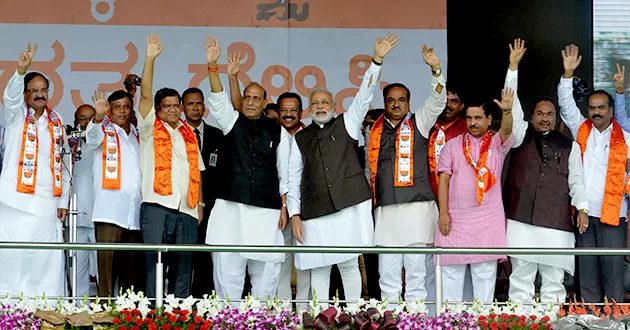Indian politics is the biggest power game known to all. There has, for this reason, always been a check on the government in power, by the opposition. 2014 was a remarkable year for India. The BJP emerged victorious with an absolute majority of 264 seats. Congress faced the worst defeat with only 40 seats in its basket.
The ‘Modi wave’ was seen all over the nation and the tagline ‘Ab Ki Baar Modi Sarkar’ happened to be the only statement that gained immediate fruition in the history of Indian politics. Past four years have been that of unpredictable and surprising events which have carried both, positive as well as negative impacts.
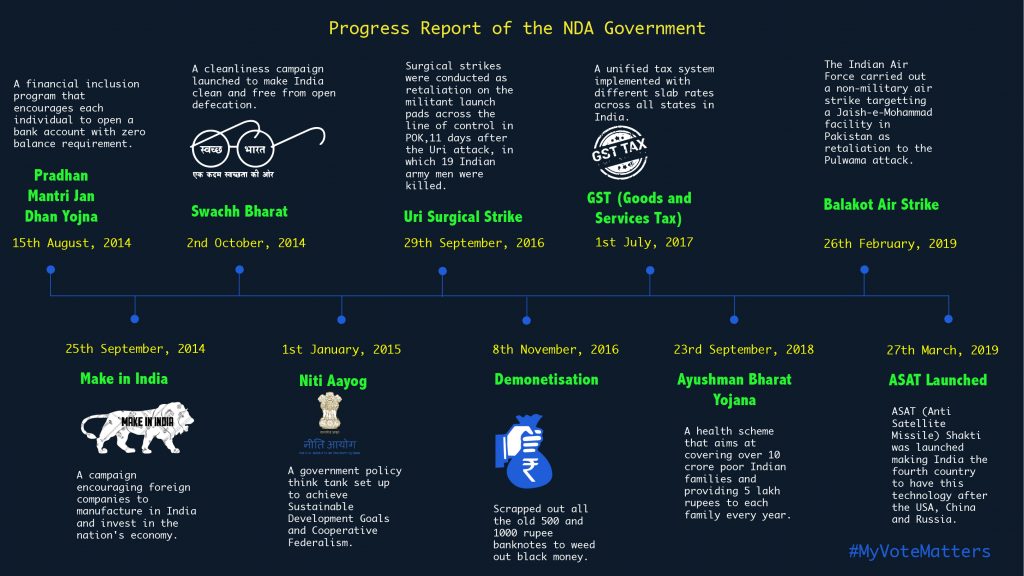
The year 2014 started with Mr. Narendra Modi taking the prime ministerial seat. The first big step that the BJP government took was the announcement of the Pradhan Mantri Jan Dhan Yojana. This scheme was launched with the aim of encouraging the habit of banking among all the Indian citizens, especially the rural Indians. Through this scheme, prime minister Narendra Modi urged people to open a savings bank account with zero balance requirement. By 2015, there were 11.5 crore households who opened bank accounts for the first time. This scheme also provided other facilities like overdraft facilities of Rs 5,000 for Aadhar linked bank accounts, issuing RuPay debit card with 1 lakh personal accident insurance cover and life cover of 30,000 and many more. The PMJDY is the largest financial inclusion program in the world.
With the motive of boosting the business industry of the nation, our PM launched the Make in India Campaign on 25th September 2014. Make in India aimed at fostering domestic production and manufacturing of goods and services. The campaign was launched to reduce India’s overdependence on foreign countries and make business in India easy. By launching the campaign, Modi intended to invite foreign companies to invest in the Indian market. The campaign although started with the right thought did not gain the expected momentum; rather the manufacturing sector saw a steady decline in the growth rate of the overall Gross Value Addition (GVA)
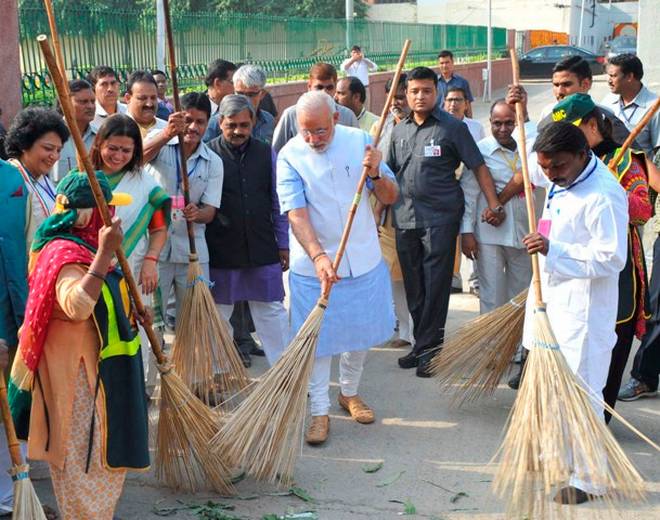
The one campaign that gained immense popularity all over the country, however, was the Swach Bharat Abhiyan. The main motive of this on-going campaign is to make India clean and free from open defecation. As a reaction to this campaign, we saw many well-known personalities joining the campaign with a broom in hand. These included Sachin Tendulkar, Akshay Kumar, Vidya Balan, Anushka Sharma, Amitabh Bachchan, etc. The campaign also aims to build atleast 12 crore toilets across the country by 2nd October 2019. By now, the Modi government claims to have built around 9.2 crore toilets. The government also claims of 5.5 lakh villages becoming free from open defecation.
2015 too began with a big step. NITI Aayog (National Institution for Transforming India) came into being that replaced the Planning Commission of India. The main role of the NITI Aayog is to be a think tank of the government and bring in fresh ideas. While the Planning Commission was the advisory committee of the government, the NITI Aayog is more than just that. It has the right to act on the suggested ideas by allocating resources to the states as well.
2016 came with a huge wave of shock with the Uri surgical strike and demonetization. While the surgical strikes carried out by the Indian army made every Indian proud, the announcement of demonetization of the 500 and 1000 rupee banknotes brought confusion and distress among people. Whether this move was a success or a failure, continues to be a debatable issue. The move of demonetization was originally intended to weed out black money. The nation, however, saw negative impacts. GDP rate dropped from 7.9% to 5.7% in April-June 2017. The terrorist activities instead of reducing increased. The nation fell short of availability of cash, which adversely affected the common man. Banks and people alike complained of improper planning and hurried the decision. On the positive side, the RBI reports stated that the detection of fake notes of denomination of 500 and 1000 decreased after demonetization. Also, the black money amounting to nearly three lakh crore, which had stayed outside the banking system, was brought back into the banks after demonetization.
Bringing in the GST (Goods and Service Tax), a unified tax system for the entire nation, was the second brave move after demonetization. The previous governments were only planning and thinking about rolling out GST, but it is the BJP government who took the risk and acted on years of planning. The countries that have implemented a single tax system faced the problem of inflation, but surprisingly India managed to escape it. The coming of GST fostered transparency in business transactions. More and more businesses signed up for GST. This tax reform aimed at putting an end to tax evasion. GST has removed restrictions on the movement of goods within the country, streamlined the distribution system, ensured single tax law for the whole nation, and combined taxes like VAT, Octroi, Service tax, excise duty, etc. Nevertheless, there a few things which still need to fall in place and will also, take time. Compliance has been a concern since the rollout. As GST involves digital processes, many businesses are taking time to understand the process. Moreover, the registration process too is cumbersome, as the firms are required to register themselves in all the states.
On 23rd September 2018, our government launched the Ayushman Bharat Yojana also known as the National Health Protection Scheme under which 10 crore families will be covered and provided with five lakh rupees per year for secondary and tertiary care hospitalization. The scheme covers both, the government as well as private hospitals. In the first 100 days of the scheme, the government claims to have provided hospital treatment to over 6.85 lakh patients. This number is said to increase, once the awareness about the scheme increases.
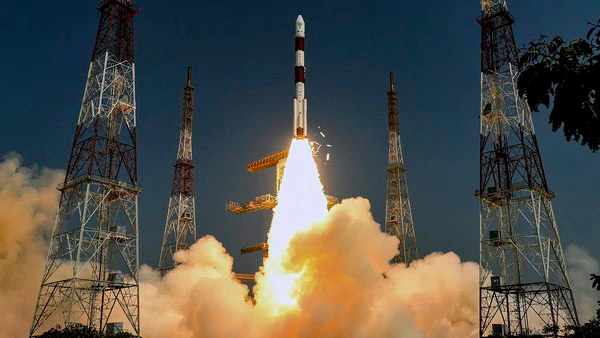
In the current year, the BJP government unfailingly surprised us all once again with the Balakot air strike which was conducted by the Indian air force on the Jaish-e-Mohammad facility in Pakistan, as a reaction to the Pulwama attack, and by launching of ASAT (Anti Satellite Missile), making India the fourth nation after the US, China and Russia, to have this technology.
Even though the Modi government took various progressive steps, it failed to deliver many important promises that have had negative impacts on the grass root level. Demonetization has wiped out an approximate of 25 lakh jobs, the price of the products and services rose, the price of petroleum too has remained high. Farmers are the most affected and distressed under the Modi government. Farmers’ suicide continues to remain a matter of concern. During the time of the BJP government, cases of lynching and mob attacks increased, criminals like Nirav Modi easily flew outside the country, and there is still a large grey area around the Rafale deal. The government has easily managed to either avoid or shush all those opposing and raising questions.
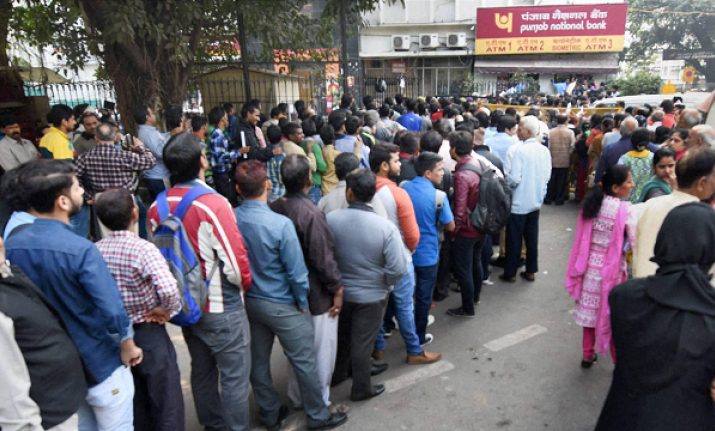
There will always be pros and cons to any party in power. Deciding for whom to vote involves a lot of thinking and analysis especially for the first time voters. This can only happen when one is aware about various important issues. We urge the first time voters to cast their vote only after a careful study of the entire scenario.





















